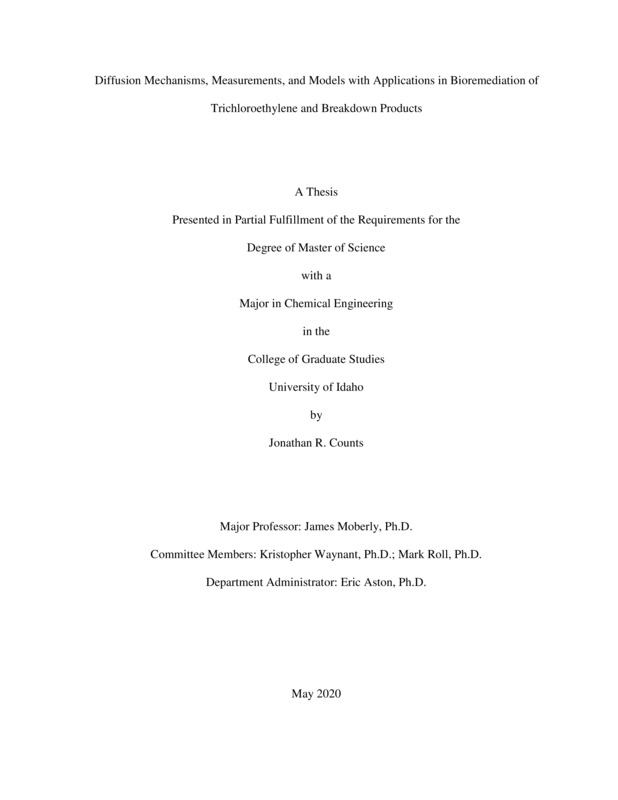Diffusion Mechanisms, Measurements, and Models with Applications in Bioremediation of Trichloroethylene and Breakdown Products
Counts, Jonathan Reilly. (2020-05). Diffusion Mechanisms, Measurements, and Models with Applications in Bioremediation of Trichloroethylene and Breakdown Products. Theses and Dissertations Collection, University of Idaho Library Digital Collections. https://www.lib.uidaho.edu/digital/etd/items/counts_idaho_0089n_11846.html
- Title:
- Diffusion Mechanisms, Measurements, and Models with Applications in Bioremediation of Trichloroethylene and Breakdown Products
- Author:
- Counts, Jonathan Reilly
- ORCID:
- 0000-0003-2063-8389
- Date:
- 2020-05
- Keywords:
- Acid Biofilm Diffusion Kinetics Remediation Trichloroethylene
- Program:
- Chemical and Materials Science Engineering
- Subject Category:
- Chemical engineering
- Abstract:
-
Trichloroethylene (TCE) is a persistent groundwater pollutant remaining from decades of use as a dry cleaning solvent and general degreaser. Having low solubility and a higher density than water, it often exists as a Dense Non-Aqueous Phase Liquid (DNAPL) at the bottom confining layer of aquifers, posing a unique remediation challenge. Bioremediation using anaerobic bacteria has proven successful, but high concentrations of TCE and proton buildup from degradation can incapacitate microbes, leaving the system “stuck”. In addition, incomplete degradation of TCE results in by-products cis-1,2-dichloroethene (cDCE) and highly toxic vinyl chloride (VC). Encapsulation of microbes in a hydrogel bead to facilitate diffusion of pollutant and adsorption of acid may allow total remediation of problem systems. In this work, a series of membranes of various compositions are tested and diffusion coefficients determined for all species of interest using the diaphragm cell method. In Chapter 3, this information is used in a model to optimize hydrogel bead size and composition for bioremediation applications.
Laboratory measurements of diffusion coefficients are time-consuming and may not be feasible for a diverse range of membrane types. It would be highly advantageous to build a correlation relating membrane properties to diffusivity. This would eliminate the need for repeated measurements using hazardous chemicals. Such a model would also allow rapid estimates of diffusion coefficients, expanding the likelihood of adoption of diffusion/reaction systems. Chapter 2 relates solute size, charge, and interactions within hydrogel membranes to steady state effective diffusivity for several molecules including hydrochloric acid. Increased understanding of the mechanisms of proton diffusion may have applications beyond bioremediation, including fuel cells and biomedical implants. Chapter 4 details future work which may improve efficacy of encapsulated cell systems.
- Description:
- masters, M.S., Chemical and Materials Science Engineering -- University of Idaho - College of Graduate Studies, 2020-05
- Major Professor:
- Moberly, James G
- Committee:
- Roll, Mark F; Waynant, Kristopher V
- Defense Date:
- 2020-05
- Identifier:
- Counts_idaho_0089N_11846
- Type:
- Text
- Format Original:
- Format:
- application/pdf
- Rights:
- In Copyright - Educational Use Permitted. For more information, please contact University of Idaho Library Special Collections and Archives Department at libspec@uidaho.edu.
- Standardized Rights:
- http://rightsstatements.org/vocab/InC-EDU/1.0/

